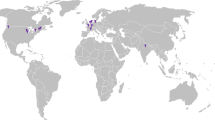Abstract
Background
Rigid sigmoidoscopy using a disposable or nondisposable sigmoidoscope is a common outpatient procedure. It has been assumed that the nondisposable bellows and light head of the sigmoidoscope remain free from enteric organisms so that the procedure is sterile if a disposable or nondisposable (metal) sigmoidoscope shaft is used. The aim of this study was to identify the presence of organisms within the bellows or light head of the sigmoidoscope.
Methods
Of 21 patients undergoing rigid sigmoidoscopy with a disposable instrument, bacterial cultures were taken from the inside of sterile Jackson-Pratt bulbs in 12 patients, with the bulbs being used to simulate the nondisposable insufflation bellows. In an additional nine patients, swabs were taken for culture from the inside of the nondisposable light head.
Results
Enteric gram-negative Escherichia coli and mixed anaerobic organisms were cultured from the Jackson-Pratt bulbs in two cases, and gram-positive organisms were cultured in another case. Gram-negative organisms, including Bacillus, Proteus mirabilis, Klebsiella, and Enterococcus faecalis, were cultured from the inside of the light head in two cases.
Conclusion
Sigmoidoscopy using a disposable instrument is not a sterile procedure and may pose a risk of patient-to-patient cross-contamination by potentially harboring organisms in the bellows or light head.
Similar content being viewed by others
References
Axtell LM, Chiazzi L (1966) Changing relative frequency of cancer of the colon and rectum in the United States. Cancer 19: 750–754
Cady B, Pearson AV, Manson DO, Maunz DL (1974) Changing patterns of colorectal carcinoma. Cancer 33: 422–426
Chapuis PH, Newland RC, Macpherson JG, Dent O, Payne J, Pheils MT (1981) The distribution of colorectal carcinoma and the relationship of tumour site to survival of patients following resection. Aust N Z J Surg 51: 127–131
Ekelund G (1963) Cancer and polyps of colon and rectum. Acta Pathol Microbiol Scand 59: 165–170
Gillespie PE, Chambers TJ, Chan KW, Doronzo F, Morson BC, Williams CB (1979) Colonic adenomas: a colonoscopic survey. Gut 20: 240–245
Keighley MRB, Williams NS (1993) Polypoid disease and polyposis syndromes (anatomical distribution). In Surgery of the anus, rectum and colon. Saunders, London, pp 760–771
Keighley MRB, Williams NS (1993) Colorectal cancer: epidemiology, aetiology, pathology, clinical features and diagnosis. In Surgery of the anus, rectum and colon. Saunders, London, pp 830–885
McDermott FT, Hughes ESR, Pihl H, Milne BJ, Price AB (1981) Comparative results of surgical management of single carcinomas of the colon and rectum: a series of 1939 patients managed by one surgeon. Br J Surg 68: 850–855
NSW Health Department. Infection control policy document circular 2002/45, pp 1–42
Rosato FE, Marks G (1981) Changing site distribution patterns of colorectal cancer at Thomas Jefferson University Hospital. Dis Colon Rectum 24: 93–96
Royal Australasian College of Surgeons (1998) A guide to infection control. Infection control in surgery policy document
Shinya H, Wolff WI (1979) Morphology, anatomic distribution and cancer potential of colonic polyps. An analysis of 7000 polyps. Ann Surg 190: 679–683
Tedesco FJ, Waye SD, Avella JR, Villabos MM (1980) Diagnostic implications of the spatial distribution of colonic mass lesions (polyps and cancer). Gastrointest Endosc 26: 95–97
Therapeutics Goods Administration (1995) Australian Therapeutics Device Bulletin No. 28
Author information
Authors and Affiliations
Corresponding author
Rights and permissions
About this article
Cite this article
Lubowski, D.Z., Newstead, G.L. Rigid sigmoidoscopy. Surg Endosc 20, 812–814 (2006). https://doi.org/10.1007/s00464-005-0580-0
Received:
Accepted:
Published:
Issue Date:
DOI: https://doi.org/10.1007/s00464-005-0580-0




